
Packaging manufacturer Ball (NYSE:BLL) fell short of the market’s revenue expectations in Q3 CY2024, with sales falling 13.7% year on year to $3.08 billion. Its non-GAAP profit of $0.91 per share was 6% above analysts’ consensus estimates.
Is now the time to buy Ball? Find out by accessing our full research report, it’s free.
Ball (BALL) Q3 CY2024 Highlights:
- Revenue: $3.08 billion vs analyst estimates of $3.13 billion (1.6% miss)
- Adjusted EPS: $0.91 vs analyst estimates of $0.86 (6% beat)
- Gross Margin (GAAP): 21.3%, up from 19% in the same quarter last year
- Operating Margin: 16.7%, up from 9.1% in the same quarter last year
- Free Cash Flow Margin: 16%, similar to the same quarter last year
- Market Capitalization: $19.49 billion
"We delivered strong third quarter results and have returned $1.25 billion to shareholders in the first nine months of 2024. Leveraging our strong financial position and leaner operating model, the company remains uniquely positioned to enable our purpose of advancing the greater use of sustainable aluminum packaging, despite the current end consumer environment in certain geographies. We continue to complement our purpose by driving innovation and sustainability on a global scale, unlocking additional manufacturing efficiencies and enabling consistent delivery of high-quality, long-term shareholder value creation," said Daniel W. Fisher, chairman and chief executive officer.
Company Overview
Started with a $200 loan in 1880, Ball (NYSE:BLL) manufactures aluminum packaging for beverages, personal care, and household products as well as aerospace systems and other technologies.
Industrial Packaging
Industrial packaging companies have built competitive advantages from economies of scale that lead to advantaged purchasing and capital investments that are difficult and expensive to replicate. Recently, eco-friendly packaging and conservation are driving customers preferences and innovation. For example, plastic is not as desirable a material as it once was. Despite being integral to consumer goods ranging from beer to toothpaste to laundry detergent, these companies are still at the whim of the macro, especially consumer health and consumer willingness to spend.
Sales Growth
A company’s long-term performance can give signals about its business quality. Even a bad business can shine for one or two quarters, but a top-tier one grows for years. Regrettably, Ball’s sales grew at a weak 1.3% compounded annual growth rate over the last five years. This shows it failed to expand in any major way, a rough starting point for our analysis.
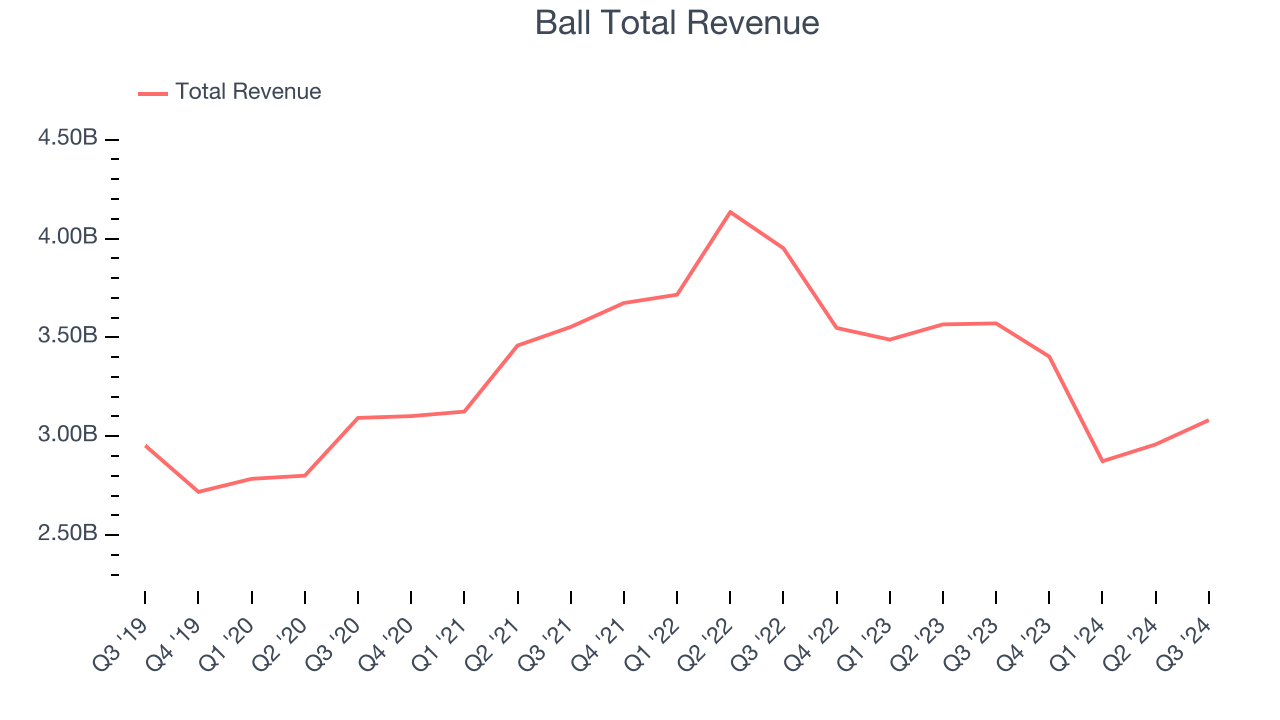
We at StockStory place the most emphasis on long-term growth, but within industrials, a half-decade historical view may miss cycles, industry trends, or a company capitalizing on catalysts such as a new contract win or a successful product line. Ball’s history shows it grew in the past but relinquished its gains over the last two years, as its revenue fell by 10.8% annually. Ball isn’t alone in its struggles as the Industrial Packaging industry experienced a cyclical downturn, with many similar businesses seeing lower sales at this time. 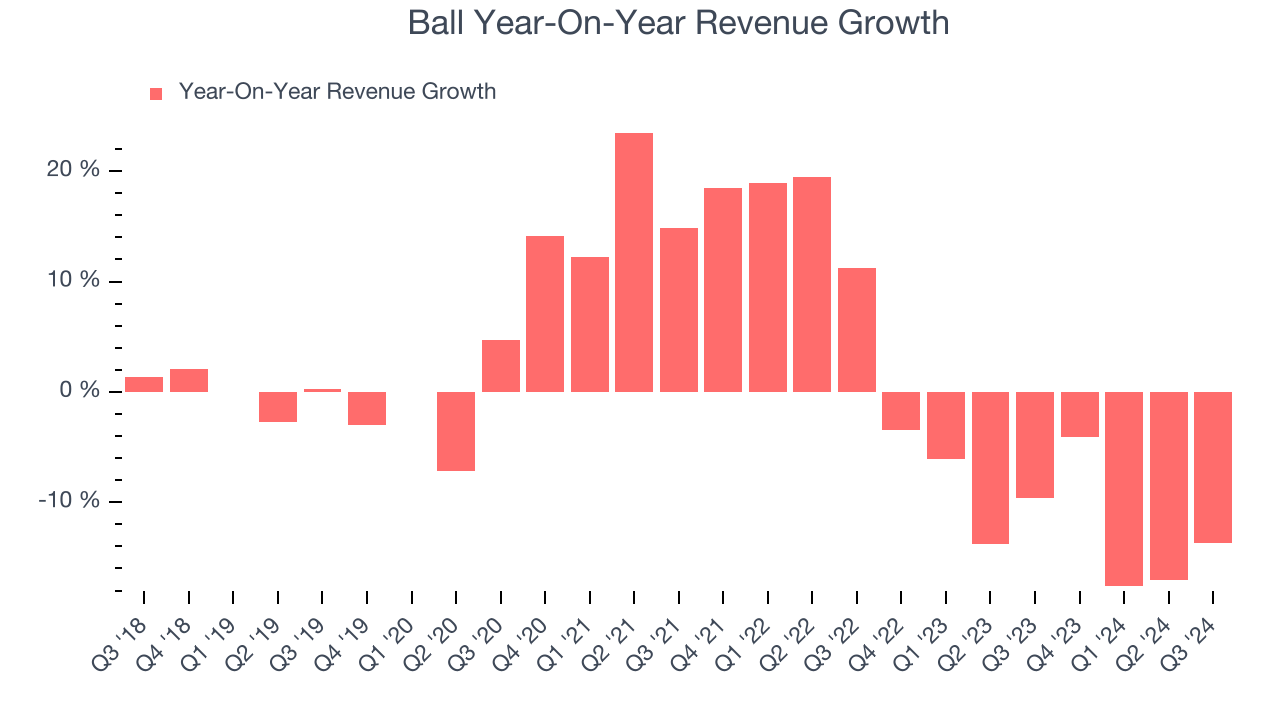
This quarter, Ball missed Wall Street’s estimates and reported a rather uninspiring 13.7% year-on-year revenue decline, generating $3.08 billion of revenue.
Looking ahead, sell-side analysts expect revenue to remain flat over the next 12 months, an improvement versus the last two years. Although this projection illustrates the market thinks its newer products and services will spur better performance, it is still below the sector average.
Today’s young investors won’t have read the timeless lessons in Gorilla Game: Picking Winners In High Technology because it was written more than 20 years ago when Microsoft and Apple were first establishing their supremacy. But if we apply the same principles, then enterprise software stocks leveraging their own generative AI capabilities may well be the Gorillas of the future. So, in that spirit, we are excited to present our Special Free Report on a profitable, fast-growing enterprise software stock that is already riding the automation wave and looking to catch the generative AI next.
Operating Margin
Ball has done a decent job managing its cost base over the last five years. The company has produced an average operating margin of 8.8%, higher than the broader industrials sector.
Analyzing the trend in its profitability, Ball’s annual operating margin rose by 2.2 percentage points over the last five years, showing its efficiency has improved.
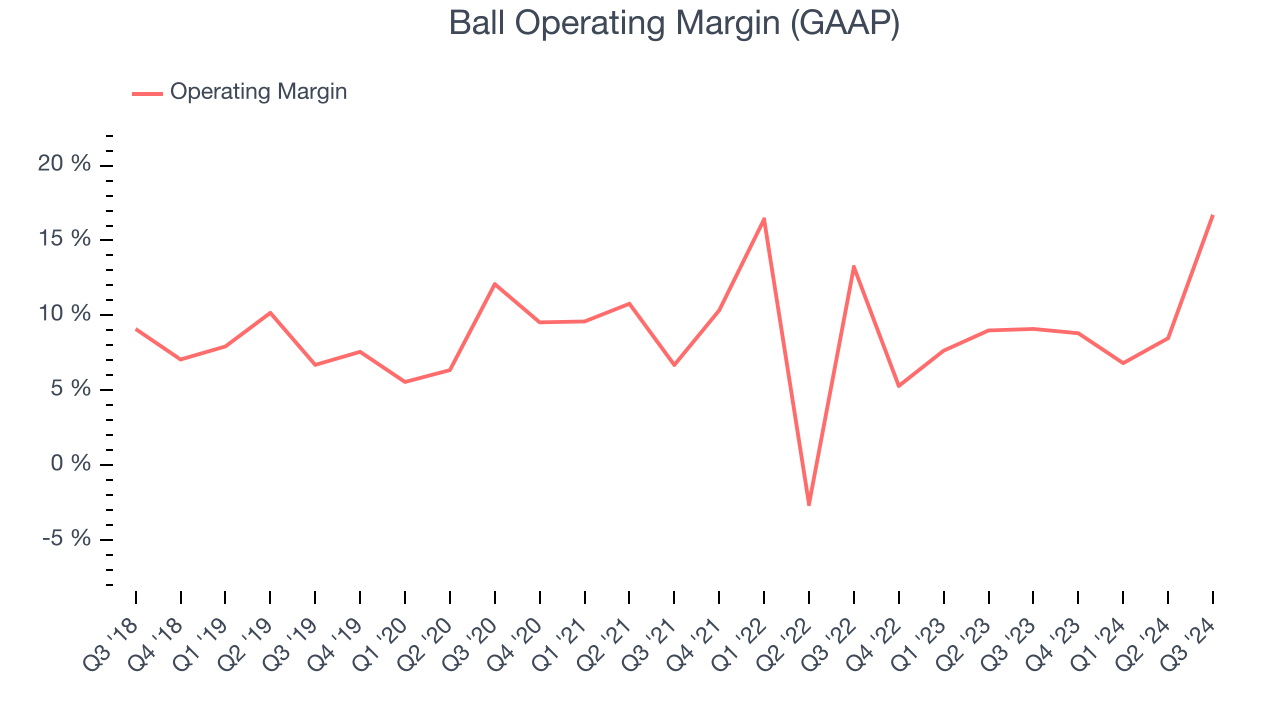
In Q3, Ball generated an operating profit margin of 16.7%, up 7.6 percentage points year on year. The increase was solid, and since its operating margin rose more than its gross margin, we can infer it was recently more efficient with expenses such as marketing, R&D, and administrative overhead.
Earnings Per Share
We track the long-term change in earnings per share (EPS) for the same reason as long-term revenue growth. Compared to revenue, however, EPS highlights whether a company’s growth was profitable.
Ball’s EPS grew at an unimpressive 5.6% compounded annual growth rate over the last five years. On the bright side, this performance was better than its 1.3% annualized revenue growth and tells us the company became more profitable as it expanded.
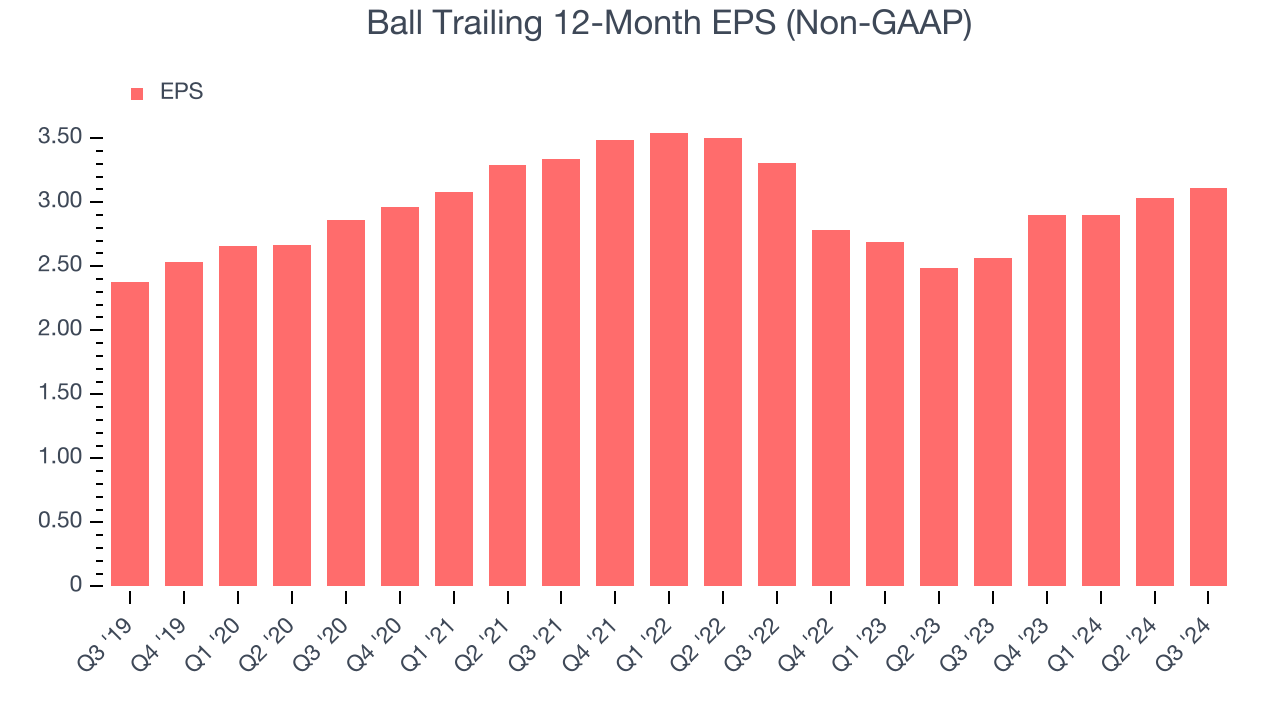
Diving into the nuances of Ball’s earnings can give us a better understanding of its performance. As we mentioned earlier, Ball’s operating margin expanded by 2.2 percentage points over the last five years. On top of that, its share count shrank by 10.4%. These are positive signs for shareholders because improving profitability and share buybacks turbocharge EPS growth relative to revenue growth. 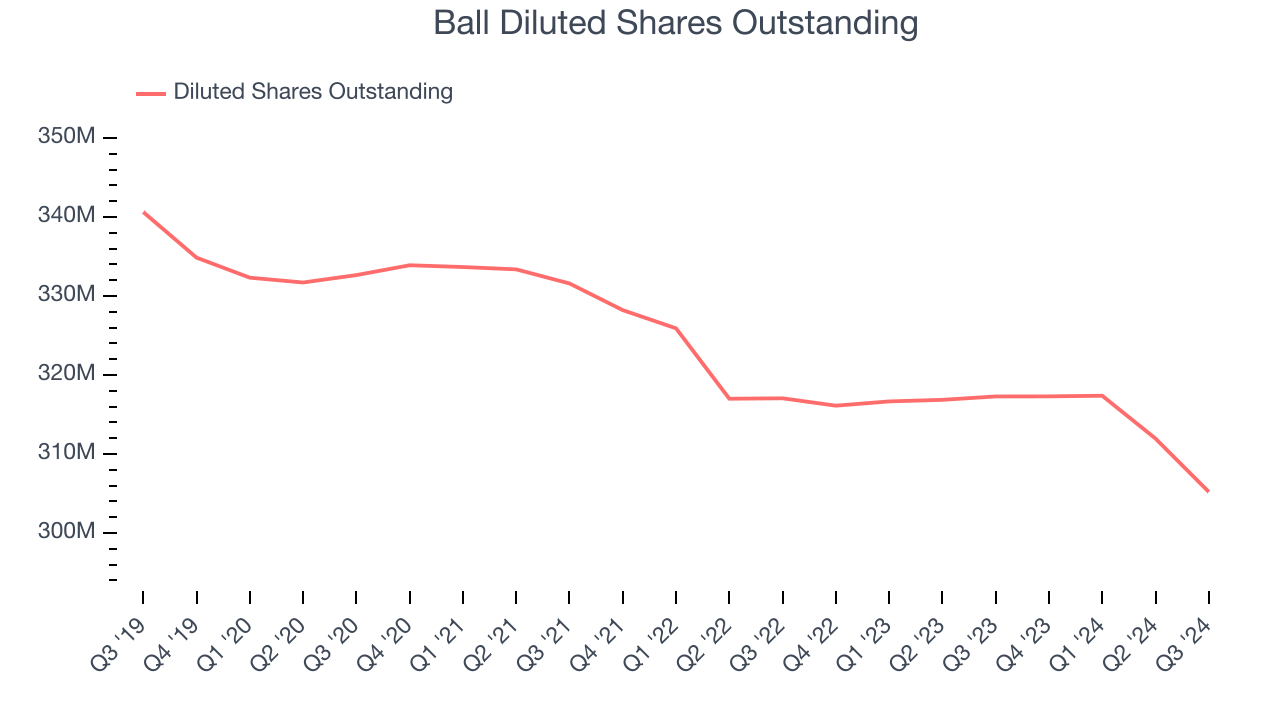
Like with revenue, we analyze EPS over a shorter period to see if we are missing a change in the business.
For Ball, its two-year annual EPS declines of 3% show it’s continued to underperform. These results were bad no matter how you slice the data.In Q3, Ball reported EPS at $0.91, up from $0.83 in the same quarter last year. This print beat analysts’ estimates by 6%. Over the next 12 months, Wall Street expects Ball’s full-year EPS of $3.11 to grow by 9.9%.
Key Takeaways from Ball’s Q3 Results
Revenue missed but EPS beat. Overall, this was a mixed quarter. The stock remained flat at $64.19 immediately after reporting.
Big picture, is Ball a buy here and now? If you’re making that decision, you should consider the bigger picture of valuation, business qualities, as well as the latest earnings. We cover that in our actionable full research report which you can read here, it’s free.













